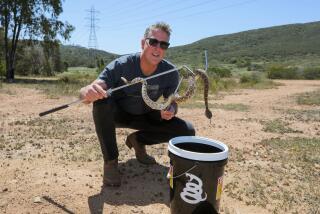Western rattlesnake
- Share via
[CROTALUS VIRIDIS]
The Western rattlesnake often evokes such knee-jerk fear and revulsion that few people take the time to admire the elegant way this essentially mild-mannered member of the viper clan cautiously explores its surroundings. Its long, moist tongue carries scent molecules into its mouth while a pair of heat-sensing pits that flank its face collect information about warm-blooded animals nearby. These pits make Western rattlesnakes particularly effective hunters of ground squirrels, their main food in many parts of California. Because rattlesnakes grow slowly and don’t breed every year, a single death inflicted by a human can have a serious impact on their population, and in many areas their numbers are decreasing.
NATURAL HISTORY
If the long, folding front fangs break off after striking prey, new fangs can move in within hours as replacements to ensure the snake is ready for danger or food.
KEY CHARACTERISTICS
A stout, greenish reptile with a thin neck and broad triangular head, the snake sometimes lacks a rattle, or if it has one it doesn’t always use it.
(For more information on rattlesnakes, see the Outdoors Institute on Page 5.)
More to Read
Sign up for The Wild
We’ll help you find the best places to hike, bike and run, as well as the perfect silent spots for meditation and yoga.
You may occasionally receive promotional content from the Los Angeles Times.






